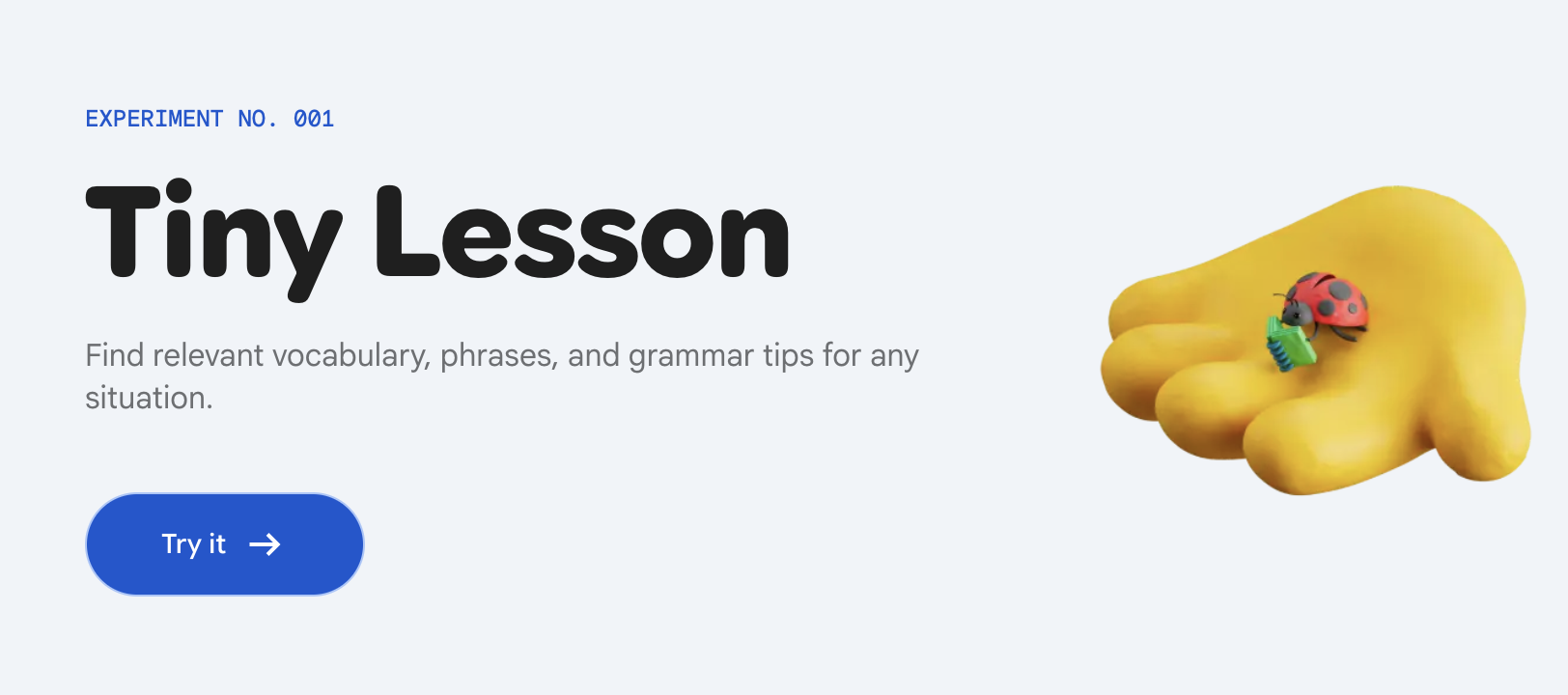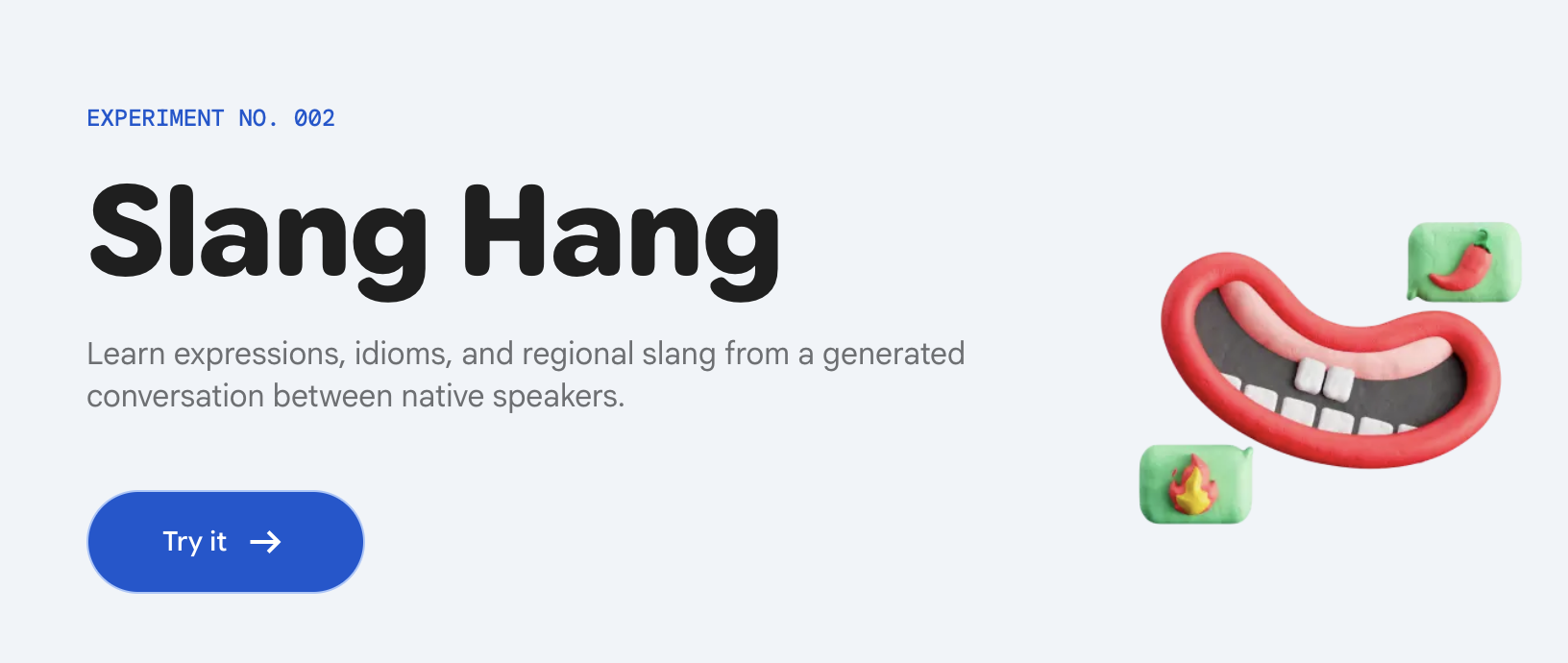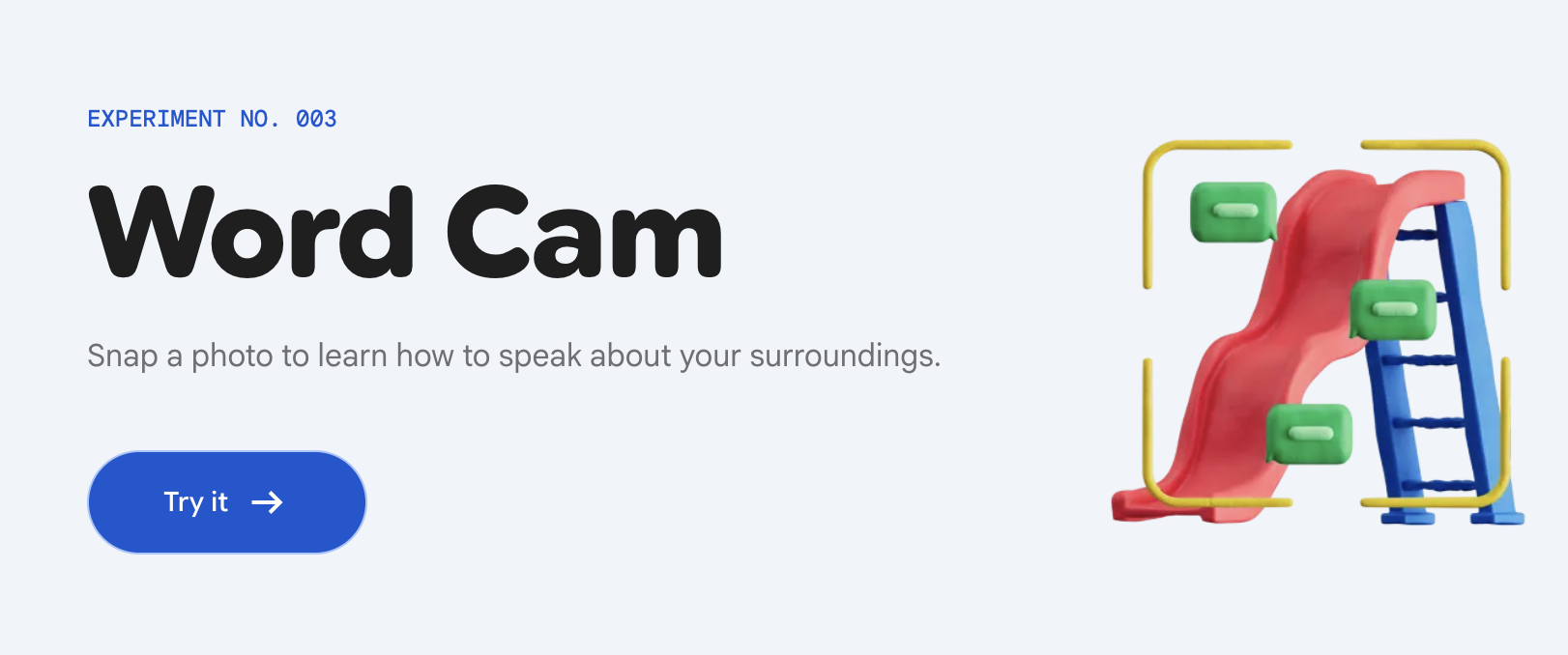- Technology base: built on Gemini 2.0 model
- Three ALI language learning experimental tools to explain
- 1 x Tiny Lesson - Situational Short Course
- Ideas: supplement traditional learning, not substitute
- The meaning and application of education
- Let’s wrap it up and say:
- How did Little Language Lessons do it?
- Three experiments, three directions
- 1 ** Tiny Lesson: High school language in the scene you need**
- Integration of other functions
- Project meaning and future outlook
Google’s “Little Language Lessons” is a group of micro-linguistic learning experiments designed to use the generator AI to enable people to practice their language at any time or place using their daily scenes. This is not a traditional language learning tool, but rather an interactive experience designed around “Immediate life scenario learning**”, encouraging users to:
-
Take advantage of day-to-day opportunities to “student”
-
Development of high-frequency, small but continuous learning habits
-
“Integration” of language learning rather than “only in the classroom”
Visit: Labs.google/lll
Technology base: built on Gemini 2.0 model
All functions are based on Google’s own Gemini 2.0 large language model with advanced abilities to understand context, generate natural dialogue, multi-model processing, etc. With Gemini, Google can build ** more intelligent, interactive and contextually sensitive language tools ** to enhance user participation and learning efficiency.
Three ALI language learning experimental tools to explain
1 x Tiny Lesson - Situational Short Course
** Function: Provides small phrases, practical sentences, simple grammatical points for specific life scenarios (e.g., “go to a coffee shop”, “by a subway”, “off-the-shelf”). ** Features:
-
It’s simple and quick. Just one little theme at a time.
-
Focus on the application scene. Let’s do it now.
-
contributes to the development of language-reaction habits**
#2 Slang Hang - Learn tunnels and slang ** Function: Generates ** Simulation dialogue in real context to help you master slang and oral expression, such as: “Th’s lit!” (I’m down for it.) ** Features**:
-
Simulate the original English-language tone and rhythm.
-
Studying non-textual expressions
-
Upgrades of hearing and natural expression
#3 Word Cam - Use camera word recognition tool Function: Open cell phone cameras, target the item and the system will immediately identify and provide the foreign language name and related usage of the item. Examples:
-
“Bananas.” There’s a banana, a phrase, a phrase.
-
Realization of ** in-kind + AI + word learning**
** Features**:
-
Real-time interaction, reading and learning.
-
Fits for visual learners.
-
To strengthen the connection between a word’s memory and life.
Ideas: supplement traditional learning, not substitute
Google made it clear that “Little Language Lessons” is not a substitute for textbooks or systems, but rather:
-
** Supplementary official course**
-
** Encouragement of interest-driven learning**
-
** Lower learning threshold and stress**
-
Helping users to keep “Language Absorption” in debris time
The meaning and application of education
This type of AI micro-learning tool is very suitable:
-
A busy class worker.
-
An interested learner who wants to integrate learning into life.
-
beginners who want to practice the terms of life and the words of hearing.
-
Users who want to improve the day-to-day functionality of a second language other than their mother tongue
Particularly suitable for “** non-compulsory learning” or “ interest-driven learners**”.
Let’s wrap it up and say:
Little Language Lessons, through Gemini AI, has made language learning lighter, more interesting and more up-to-date, and has made it possible for “every coffee, text, photo” to become a learning opportunity.
How did Little Language Lessons do it?
A pilot system for personalized language learning based on the Gemini model ** The original purpose of the project is to make language learning “situative, practical” as a programming exercise** The author, Aaron Wade, is a developer and a language lover. He observes that learning programming often starts with “writing a runable small project”, while language learning often starts with educational materials that are out of context. He wants to change this:** making language learning “in context”, “in real time”, “life drive”**. So he started this experiment with a group of colleagues, Gemini API, based on Google.
Three experiments, three directions
1 ** Tiny Lesson: High school language in the scene you need**
One of the most frustrating things about learning language is that you’re in a situation where you need a word or a word, and you haven’t learned it yet. This is the point of departure for Tiny Lesson. You describe a scene — like a question road or a lost passport — where the system provides useful vocabulary, phrases and syntax tips. ** Practice:** Users enter a scenario (e.g., “questioning” or “lost passport”) that allows the system to export ** key vocabulary, common phrases and syntax elements** from the scene. ** Technological realization:**
-
Use Gemini API+JSON output structure
-
Set the word “prompt” to read: “You’re a bilingual teacher, customize the vocabulary of the scene for the students.”
You’re a {target language} tutor, good at {target language} and {source language} and good at customizing content according to the student’s language. You are a (n) {target landie} tutu who is bilingual in {target landie} and And an expert at craving emergency content that is I’m sorry, Master, but I’m sorry, I’m sorry, but I’m sorry.
- In this prompt and all subsequent prompts, we have used Gemini’s ability to provide structured JSON output, defining what we want to produce as follows:
Generates a JSON object with two keys: “vocabulary” and “phrases” for the given use scenario. The value of “vocabulary” should be a array of objects, each containing three keys: “term”, “translation” and “translation”. The value for “term” should be the most commonly used word for {target language} in the scene. If the language itself uses the Latin alphabet, “translation” should be an empty string. Otherwise, the word should be translated. The value of “translation” is the translation of the word {source language}. I don’t know.
- The structure includes: vocabulary: Vocabulary + Spelling/ Audio Translation + Translation
-phrases: Common sentences.
- GrammarTips: Syntax Proposal (another proposal)
In general, each course is generated by two Gemini API calls: one to generate vocabulary and phrases and the other to produce relevant syntax points. At the end of each prompt, the context content specified by the user will be embedded as follows: Enter scene (INPUT user contact): {user input} #2 Slang Hang: Speak like locals ** Practice:** In a real-life setting,** tunnel dialogues, such as friends meeting, street chatting, colleagues meeting on the subway, etc., are developed to learn language and expression habits. When your language learning is going well and you can talk, express and communicate well, you suddenly realize that you sound too rigid. It’s too formal, too rigid. Slang Hang was designed to solve this problem. The idea is simple: to create a real native-tongue conversation where users can learn to express themselves. You can talk about each sentence, and the system can explain unfamiliar expressions. The preface to Slang Hang is as follows: ** Technological realization:
-
Set up the role of “Language and Culture Writers”
-
Geneni API to generate the entire dialogue structure (JSON format) at once, including: Dialogue background (context)
-
Sessional dialogue (speaker, message, notes)
Support click term interpretation, translation and flip learning Use Google Cloud Transport API to achieve bilingual support The preface to Slang Hang is as follows: You’re a screenwriter who’s good at {source language} and {target language}, and you’re good at an interesting conversation. You’re also a linguist who knows the cultural details that affect natural spoken languages. You are a scener who is bilingual in {source lineage} and And an expert and craving captivating dialogues. You are also a linguist and highly attached to the cultural numbers that While the user can only see one conversation at a time, all of the elements, including scenario setting, complete dialogue, terminology interpretation, are generated by a Gemini API call. The JSON output structure we define is as follows: Creates a short scenario with two interlocutors who use {target language}. The returned JSON object should contain two keys: “context” and “dialogue”. “Context”: a small text that describes scenes, interlocutors’ identities and relationships in {source language}. “Dialogue”: The array for the content of the dialogue, each of which consists of: “speaker”, “gender” (gender), “message” (text of sentence), “notes” (interpretation note) …the content of the dialogue is targeted in a language that users can click on to translate into their mother tongue (this function is achieved through the Cloud Transmission API). One of the highlights of this experiment is “generation storyality” — no scenes are repeated — perhaps: vendors chat with customers, two colleagues on the subway meet by chance, or old friends who have not seen for years meet again at the pet show. ** Challenges and constraints:** Of course, it also has some accuracy problems: sometimes it is misused or fictitious. After all, the larger language model is not perfect, and users are advised to cross-check the source of the term.
##3 Word Cam: Scrubbing through lenses ** Sometimes you just want to know what the target language is. You might say “window,” but do you know what “window” or “brows” means? Word Cam turns your camera into an instant vocabulary assistant. When you take a picture, Gemini detects the objects in the image, labels them in the target language and provides more descriptive terms. ** Practice: Open the cell phone camera and film the object, and the system will identify the object and give them ** foreign language names, translations, sentences. ** Technological realization:
-
Target identification** (object detection) using Gemini’s visual ability
-
The letter structure consists of: Description, translation, coordinates of all objects in the image
-
Generate “Description Vocabulary + Example Sentence + Translation” for an object that the user clicks on
The experiment relies on Gemini’s visual features for target testing. We send pictures to models requesting them to identify the boundary coordinates of each object in the image: Please analyse the object in the picture. The returned JSON object should contain a key “objects”. The value of “objects” is a array of objects, each with four keys: “name” (name), “translation”, “translation” (translation), “coordinates” (coordinate). “coordinates” is an integer array representing the border frame coordinates [ymin, xmin, ymax, xmax] …when the user selects an object, we crop its image and send it again to Gemini, generating a detailed description of the object: Please specify the object according to the image and generate a description vocabulary. The returned JSON object should contain a key “descriptors”. “descriptors” is a array of objects, each of which includes: “descriptor”; “translation”; “examplesession” (examples); “example CouncilTranslation” (examples); “example CouncilTranslation” (examples) I don’t know.
Integration of other functions
All three experimental products have been added to voice playback to help users hear the natural pronunciation of the target language.
-
** Voice Speak**: This function is achieved through Claude Text-to-Speech API, covering mainstream languages, but less supportive of small languages. Regional accents are also limited and sometimes inconsistent with the dialects chosen by the user.
-
** Attention**: Some language accents are limited (influence of dialects is insufficient)
-
Lack of high-quality sound models in some minority languages
Project meaning and future outlook
The experiment shows the new possibilities of AI in personalized language learning:
-
The ability to generate content instantaneously based on the “situation of the user”
-
A learning path that helps to form “fragmentation + living”
-
Can be applied in the early and medium learning stages, especially for enhancing the ability to express themselves in practice**




